Discover 50 hidden attractions, cool sights, and unusual things to do in France. Don't miss out on these must-see attractions: Champs-Élysées (Paris), Musée du Louvre (Paris) or Eiffel Tower (Paris).
Below, you can find the list of the most amazing places you should visit in France.
Table of Contents
Champs-Élysées, Paris

Iconic site of landmarks, dining and shops. The Avenue des Champs-Élysées is an avenue in the 8th arrondissement of Paris, France, 1.9 kilometres long and 70 metres wide, running between the Place de la Concorde in the east and the Place Charles de Gaulle in the west, where the Arc de Triomphe is located. It is known for its theatres, cafés and luxury shops, as the finish of the Tour de France cycling race, as well as for its annual Bastille Day military parade. The name is French for the Elysian Fields, the place for dead heroes in Greek mythology. It is commonly regarded as the "most beautiful avenue in the world".[1]
Address: 27-33 avenue des Champs-Élysées, 75008 Paris (Élysée)
Musée du Louvre, Paris

Landmark art museum with vast collection. The Louvre, or the Louvre Museum, is the world's most-visited museum, and a historic landmark in Paris, France. It is the home of some of the best-known works of art, including the Mona Lisa and the Venus de Milo. A central landmark of the city, it is located on the Right Bank of the Seine in the city's 1st arrondissement. At any given point in time, approximately 38,000 objects from prehistory to the 21st century are being exhibited over an area of 72,735 square meters. Attendance in 2021 was 2.8 million due to the COVID-19 pandemic. The museum was closed for 150 days in 2020, and attendance plunged by 72 percent to 2.7 million. Nonetheless, the Louvre still topped the list of most-visited art museums in the world in 2021.
The museum is housed in the Louvre Palace, originally built in the late 12th to 13th century under Philip II. Remnants of the Medieval Louvre fortress are visible in the basement of the museum. Due to urban expansion, the fortress eventually lost its defensive function, and in 1546 Francis I converted it into the primary residence of the French Kings. The building was extended many times to form the present Louvre Palace. In 1682, Louis XIV chose the Palace of Versailles for his household, leaving the Louvre primarily as a place to display the royal collection, including, from 1692, a collection of ancient Greek and Roman sculpture. In 1692, the building was occupied by the Académie des Inscriptions et Belles-Lettres and the Académie Royale de Peinture et de Sculpture, which in 1699 held the first of a series of salons. The Académie remained at the Louvre for 100 years. During the French Revolution, the National Assembly decreed that the Louvre should be used as a museum to display the nation's masterpieces.
The museum opened on 10 August 1793 with an exhibition of 537 paintings, the majority of the works being royal and confiscated church property. Because of structural problems with the building, the museum was closed in 1796 until 1801. The collection was increased under Napoleon and the museum was renamed Musée Napoléon, but after Napoleon's abdication, many works seized by his armies were returned to their original owners. The collection was further increased during the reigns of Louis XVIII and Charles X, and during the Second French Empire the museum gained 20,000 pieces. Holdings have grown steadily through donations and bequests since the Third Republic. The collection is divided among eight curatorial departments: Egyptian Antiquities; Near Eastern Antiquities; Greek, Etruscan, and Roman Antiquities; Islamic Art; Sculpture; Decorative Arts; Paintings; Prints and Drawings.
The Musée du Louvre contains more than 380,000 objects and displays 35,000 works of art in eight curatorial departments with more than 60,600 square metres dedicated to the permanent collection. The Louvre exhibits sculptures, objets d'art, paintings, drawings, and archaeological finds.[2]
Address: Rue de Rivoli, 75001 Paris (Louvre)
Eiffel Tower, Paris
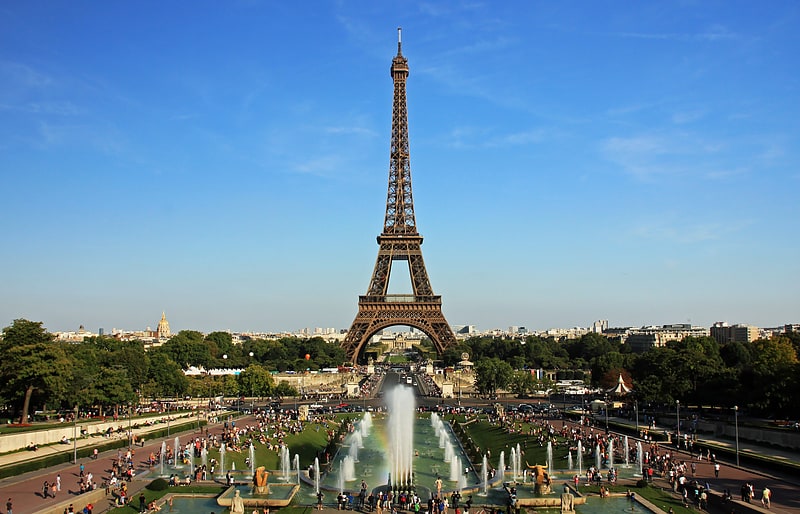
Also known as: Tour Eiffel
Landmark 324m-high 19th-century tower. The Eiffel Tower is a wrought-iron lattice tower on the Champ de Mars in Paris, France. It is named after the engineer Gustave Eiffel, whose company designed and built the tower.
Locally nicknamed "La dame de fer" (French for "Iron Lady"), it was constructed from 1887 to 1889 as the centerpiece of the 1889 World's Fair and was initially criticized by some of France's leading artists and intellectuals for its design, but it has become a global cultural icon of France and one of the most recognizable structures in the world. The Eiffel Tower is the most visited monument with an entrance fee in the world; 6.91 million people ascended it in 2015. The Tower was made a Monument historique in 1964 and named part of UNESCO World Heritage Site ("Paris, Banks of the Seins") in 1991.
The tower is 330 metres (1,083 ft) tall, about the same height as an 81-storey building, and the tallest structure in Paris. Its base is square, measuring 125 metres (410 ft) on each side. During its construction, the Eiffel Tower surpassed the Washington Monument to become the tallest man-made structure in the world, a title it held for 41 years until the Chrysler Building in New York City was finished in 1930. It was the first structure in the world to surpass both the 200-metre and 300-metre mark in height. Due to the addition of a broadcasting aerial at the top of the tower in 1957, it is now taller than the Chrysler Building by 5.2 metres (17 ft). Excluding transmitters, the Eiffel Tower is the second tallest free-standing structure in France after the Millau Viaduct.
The tower has three levels for visitors, with restaurants on the first and second levels. The top level's upper platform is 276 m (906 ft) above the ground – the highest observation deck accessible to the public in the European Union. Tickets can be purchased to ascend by stairs or lift to the first and second levels. The climb from ground level to the first level is over 300 steps, as is the climb from the first level to the second. Although there is a staircase to the top level, it is usually accessible only by lift.[3]
Address: 5 Avenue Anatole France, 75007 Paris (Palais-Bourbon)
Palais des Papes, Avignon
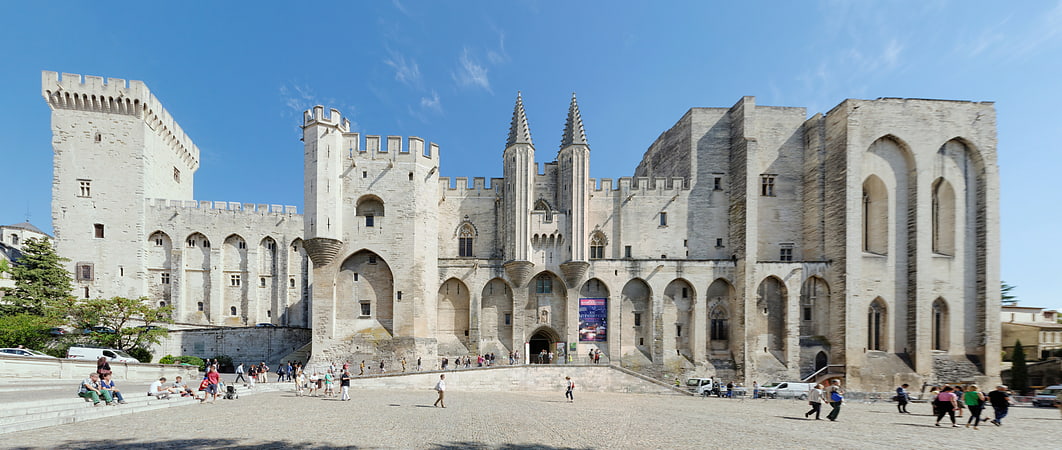
Also known as: Palais des papes d'Avignon
14th-century papal palace with frescoes. The Palais des Papes is a historical palace located in Avignon, Southern France. It is one of the largest and most important medieval Gothic buildings in Europe. Once a fortress and palace, the papal residence was the seat of Western Christianity during the 14th century. Six papal conclaves were held in the Palais, leading to the elections of Benedict XII in 1334, Clement VI in 1342, Innocent VI in 1352, Urban V in 1362, Gregory XI in 1370 and Benedict XIII in 1394. Since 1995, the Palais des Papes has been classified, along with the historic center of Avignon, as a UNESCO World Heritage Site, for its outstanding architecture and historical importance for the Papacy.[4]
Address: Place du Palais, 84000 Avignon (Intra-Muros)
Palace of Versailles, Versailles
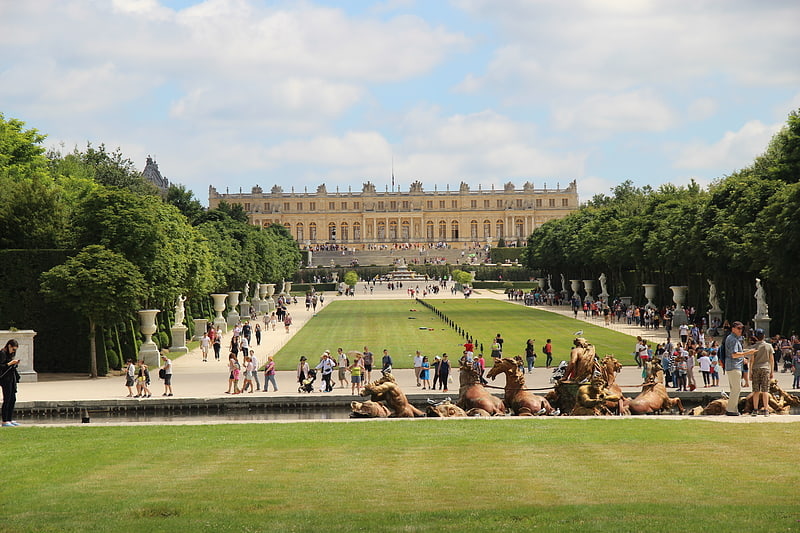
Also known as: Château de Versailles
Louis XIV's gilded palace and gardens. The Palace of Versailles is a former royal residence located in Versailles, about 12 miles west of Paris, France. The palace is owned by the French Republic and has since 1995 been managed, under the direction of the French Ministry of Culture, by the Public Establishment of the Palace, Museum and National Estate of Versailles. 15,000,000 people visit the Palace, Park, or Gardens of Versailles every year, making it one of the most popular tourist attractions in the world. However, due to the COVID-19 pandemic, the number of paying visitors to the Chateau dropped by 75 percent from eight million in 2019 to two million in 2020. The drop was particularly sharp among foreign visitors, who account for eighty percent of paying visitors.
Louis XIII built a simple hunting lodge on the site of the Palace of Versailles in 1623 and replaced it with a small château in 1631–34. Louis XIV expanded the château into a palace in several phases from 1661 to 1715. It was a favorite residence for both kings, and in 1682, Louis XIV moved the seat of his court and government to Versailles, making the palace the de facto capital of France. This state of affairs was continued by Kings Louis XV and Louis XVI, who primarily made interior alterations to the palace, but in 1789 the royal family and capital of France returned to Paris. For the rest of the French Revolution, the Palace of Versailles was largely abandoned and emptied of its contents, and the population of the surrounding city plummeted.
Napoleon Bonaparte, following his takeover of France, used Versailles as a summer residence from 1810 to 1814, but did not restore it. When the French Monarchy was restored, it remained in Paris and it was not until the 1830s that meaningful repairs were made to the palace. A museum of French history was installed within it, replacing the apartments of the southern wing.
The palace and park were designated a World Heritage Site by UNESCO in 1979 for its importance as the center of power, art, and science in France during the 17th and 18th centuries. The French Ministry of Culture has placed the palace, its gardens, and some of its subsidiary structures on its list of culturally significant monuments.[5]
Address: Place d'Armes, 78000 Versailles (Saint-Louis - Château)
Pont Saint-Bénézet, Avignon

Historic remains of 12th-century bridge. The Pont Saint-Bénézet, also known as the Pont d'Avignon, was a medieval bridge across the Rhône in the town of Avignon, in southern France. Only four arches survive.
A wooden bridge spanning the Rhône between Villeneuve-lès-Avignon and Avignon was built between 1177 and 1185. This early bridge was destroyed forty years later in 1226 during the Albigensian Crusade when Louis VIII of France laid siege to Avignon. Beginning in 1234 the bridge was rebuilt with 22 stone arches. The stone bridge was about 900 m (980 yd) in length and only 4.9 m (16 ft 1 in) in width, including the parapets at the sides. The bridge was abandoned in the mid-17th century as the arches tended to collapse each time the Rhône flooded making it very expensive to maintain. Four arches and the gatehouse at the Avignon end of the bridge have survived. The Chapel of Saint Nicholas which sits on the second pier of the bridge, was constructed in the second half of 12th century but has since been substantially altered. The western terminus, the Tour Philippe-le-Bel, is also preserved.
The bridge was the inspiration for the song Sur le pont d'Avignon and is considered a landmark of the city. In 1995, the surviving arches of the bridge were classified as a World Heritage Site, together with the Palais des Papes, Cathédrale Notre-Dame des Doms, and other monuments from the historic centre of Avignon, because of its testimony to Avignon's leading role in the Papacy during the 14th and 15th centuries.[6]
Address: Boulevard de la Ligne, 84000 Avignon (Intra-Muros)
Walls of Avignon, Avignon
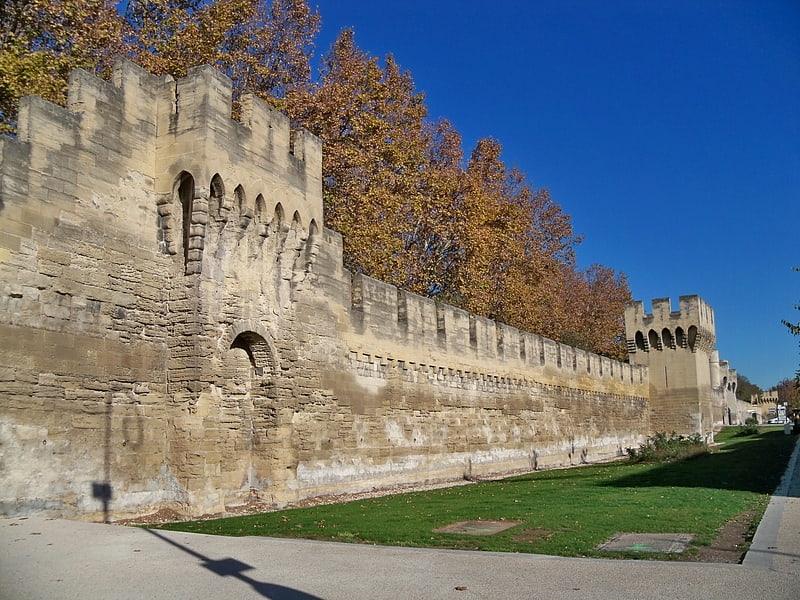
Fortress in Avignon, France. The walls of Avignon are a series of defensive stone walls that surround the city of Avignon in the south of France. They were originally built in the 14th century during the Avignon papacy and have been continually rebuilt and repaired throughout their subsequent history.
The walls replaced an earlier double set of defensive walls that had been completed in the first two decades of the 13th century. During the Albigensian Crusade the town sided with the Count of Toulouse, Raymond VII but in 1226, after a three-month siege by Louis VIII of France, Avignon capitulated and was forced to dismantle the walls and fill in the moats. Beginning in around 1231, the defences were rebuilt. Although these early walls have not survived, their path is preserved in the street plan of the city.
In 1309 Pope Clement V moved to Avignon and under the papacy the town expanded outside the limits of the earlier city walls. From the 1350s during the Hundred Years' War the town became vulnerable to pillage by marauding bands of mercenaries and in 1357 under Innocent VI, the fifth Avignon pope, work began on the construction of new set of city walls to enclose the expanded town. The walls took nearly 20 years to complete.
The walls stretch for 4.3 km (2.7 mi) and enclose an area of 150 ha (370 acres). There were originally twelve gates controlling access to the city but this number was reduced to seven when the fortifications were modified between 1481 and 1487. There are now 15 vehicular entrances and 11 pedestrian entrances.[7]
Address: Boulevard de la Ligne, 84000 Avignon (Intra-Muros)
Notre-Dame de la Garde, Marseille
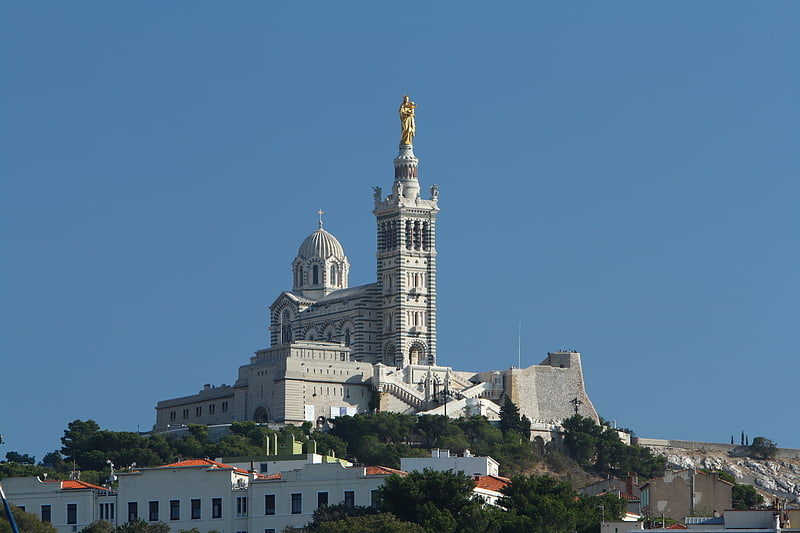
Also known as: Basilique Notre-Dame-de-la-Garde
Landmark basilica with city views. Notre-Dame de la Garde, known to local citizens as la Bonne Mère, is a Catholic basilica in Marseille, France, and the city's best-known symbol. The site of a popular Assumption Day pilgrimage, it was the most visited site in Marseille. It was built on the foundations of an ancient fort at the highest natural point in Marseille, a 149 m limestone outcropping on the south side of the Old Port of Marseille.
Construction of the basilica began in 1853 and lasted for over forty years. It was originally an enlargement of a medieval chapel but was transformed into a new structure at the request of Father Bernard, the chaplain. The plans were made and developed by the architect Henri-Jacques Espérandieu. It was consecrated while still unfinished on 5 June 1864. The basilica consists of a lower church or crypt in the Romanesque style, carved from the rock, and an upper church of Neo-Byzantine style decorated with mosaics. A square 41 m (135 ft) bell tower topped by a 12.5 m (41 ft) belfry supports a monumental 11.2 m (37 ft) statue of the Madonna and Child, made of copper gilded with gold leaf.
An extensive restoration from 2001 to 2008 included work on mosaics damaged by candle smoke, green limestone from Gonfolina which had been corroded by pollution, and stonework that had been hit by bullets during the Liberation of France. The restoration of the mosaics was entrusted to Marseille artist Michel Patrizio, whose workmen were trained in Friuli, north of Venice, Italy. The tiles were supplied by the workshop in Venice which had made the originals.[8]
Address: Rue Fort du Sanctuaire, 13281 Marseille (7éme Arrondissement)
Bordeaux Cathedral, Bordeaux
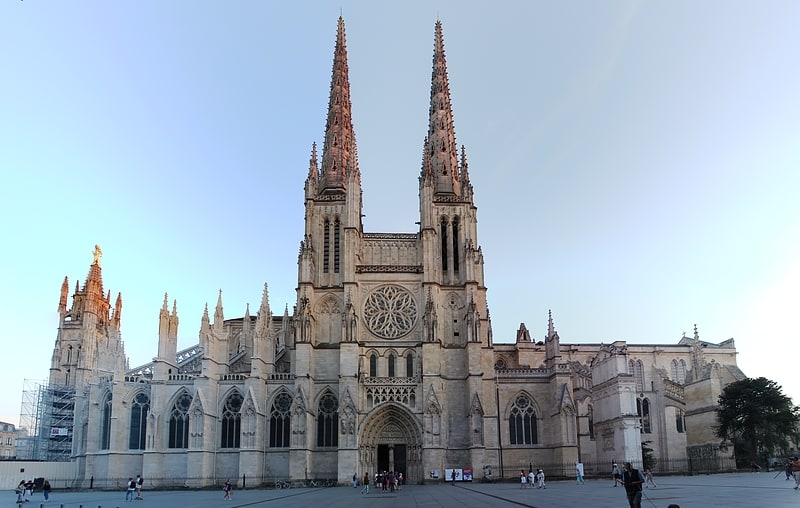
Also known as: Cathédrale Saint-André de Bordeaux
Landmark 11th-century Catholic cathedral. Bordeaux Cathedral, officially known as the Primatial Cathedral of St Andrew of Bordeaux, is a Roman Catholic church dedicated to Saint Andrew and located in Bordeaux, France. It is the seat of the Archbishop of Bordeaux.
In 1998, UNESCO designated the Routes of Santiago de Compostela in France as a World Heritage site, including the three main churches of Bordeaux: the basilica of St Severinus, the basilica of St Michael and the cathedral of St Andrew.[9]
Address: Place Pey-Berland, 33000 Bordeaux (Hôtel de Ville Quinconces)
St Jean Cathedral, Lyon
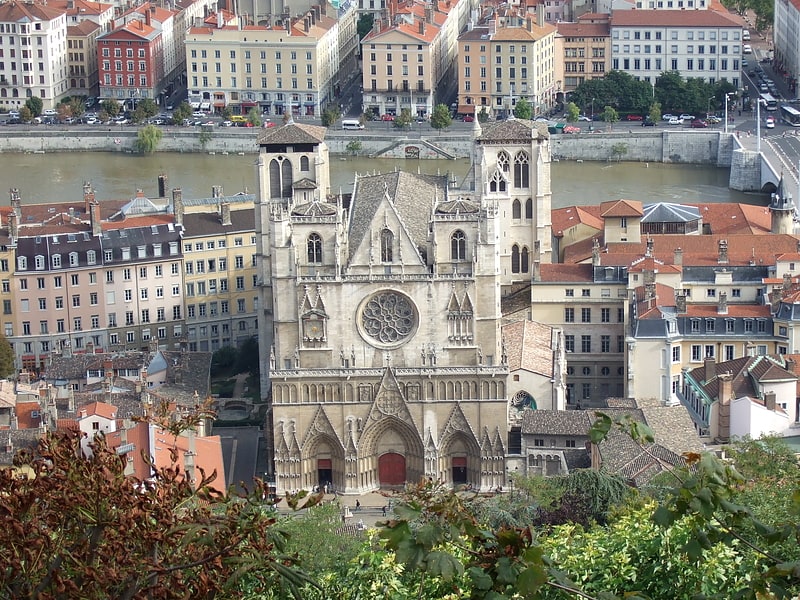
Also known as: Primatiale Saint-Jean de Lyon
Cathedral housing 14th-century treasures. Lyon Cathedral is a Roman Catholic church located on Place Saint-Jean in central Lyon, France. The cathedral is dedicated to Saint John the Baptist, and is the seat of the Archbishop of Lyon. Begun in 1180 on the ruins of a 6th-century church, it was completed in 1476. Despite its long construction time, it has a relatively consistent architectural style. In 1998, the building, along with other historic sites in the center of Lyon, was inscribed on the UNESCO World Heritage List.[10]
Address: Place Saint-Jean, 69005 Lyon (Arrondissement 5E)
Villa Ephrussi de Rothschild, Nice
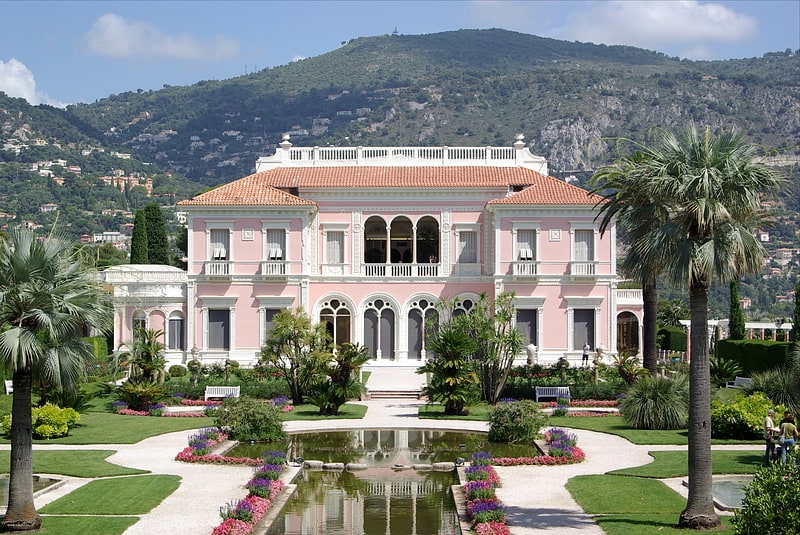
Museum in Saint-Jean-Cap-Ferrat, France. The Villa Ephrussi de Rothschild, also called Villa Île-de-France, is a French seaside villa located at Saint-Jean-Cap-Ferrat on the French Riviera. Designed by the French architect Aaron Messiah, it was built between 1907 and 1912 by Baroness Béatrice de Rothschild.
A member of the Rothschild banking family and the wife of the banker Baron Maurice de Ephrussi, Béatrice de Rothschild built her rose-colored villa on a promontory on the isthmus of Cap Ferrat overlooking the Mediterranean Sea. The Baroness filled the mansion with antique furniture, Old Master paintings, sculptures, objets d'art and assembled an extensive collection of rare porcelain. The gardens are classified by the Ministry of Culture as one of the Remarkable Gardens of France, whilst the villa itself has been classified as a monument historique since 1996.
Upon her death in 1934, the Baroness donated the property and its collections to the Académie des Beaux-Arts division of the Institut de France. It is now open to the public.[11]
Address: 1 Avenue Ephrussi de Rothschild, 06230 Saint-Jean-Cap-Ferrat
Hall of Mirrors, Versailles
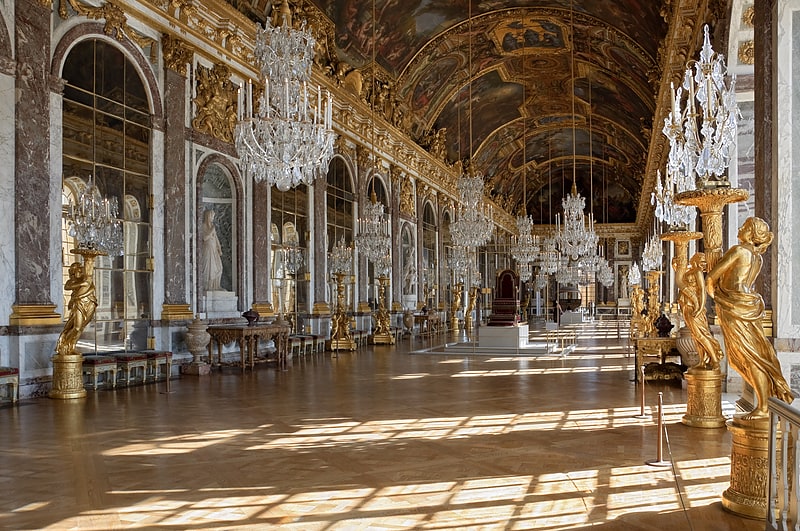
Also known as: Galerie des Glaces
Iconic Louis XIV-era mirrored gallery. The Hall of Mirrors is a grand Baroque style gallery and one of the most emblematic rooms in the royal Palace of Versailles near Paris, France. The grandiose ensemble of the Hall and its adjoining salons was intended to illustrate the power of the absolutist monarch Louis XIV. Located on the first floor of the palace's central body, it faces west towards the Palace Gardens. The Hall of Mirrors has been the scene of events of great historic significance, including the Proclamation of the German Empire and the signing of the Treaty of Versailles.[12]
Address: Place d'Armes, 78000 Versailles (Saint-Louis - Château)
Esplanade de Fourvière, Lyon

Also known as: Basilique Notre-Dame de Fourvière
Hilltop church with religious art museum. The Basilica of Notre-Dame de Fourvière is a minor basilica in Lyon. It was built with private funds between 1872 and 1896 in a dominant position overlooking the city. The site it occupies was once the Roman forum of Trajan, the forum vetus, thus its name.[13]
Address: 8 Place de Fourvière, 69005 Lyon (Arrondissement 5E)
Strasbourg Cathedral, Strasbourg

Also known as: Cathédrale Notre-Dame de Strasbourg
Gothic building with astronomical clock. Strasbourg Cathedral or the Cathedral of Our Lady of Strasbourg, also known as Strasbourg Minster, is a Catholic cathedral in Strasbourg, Alsace, France. Although considerable parts of it are still in Romanesque architecture, it is widely considered to be among the finest examples of Rayonnant Gothic architecture. Architect Erwin von Steinbach is credited for major contributions from 1277 to his death in 1318, and beyond through his son Johannes von Steinbach, and his grandson Gerlach von Steinbach, who succeeded him as chief architects. The Steinbachs's plans for the completion of the cathedral were not followed through by the chief architects who took over after them, and instead of the originally envisioned two spires, a single, octagonal tower with an elongated, octagonal crowning was built on the northern side of the west facade by master Ulrich von Ensingen and his successor, Johannes Hültz. The construction of the cathedral, which had started in the year 1015 and had been relaunched in 1190, was finished in 1439.
At 142 metres (466 feet), Strasbourg Cathedral was the world's tallest building from 1647 to 1874 (227 years), when it was surpassed by St. Nikolai's Church, Hamburg. Today it is the sixth-tallest church in the world and the highest still standing extant structure built entirely in the Middle Ages.
Described by Victor Hugo as a "gigantic and delicate marvel", and by Goethe as a "sublimely towering, wide-spreading tree of God", the cathedral is visible far across the plains of Alsace and can be seen from as far off as the Vosges Mountains or the Black Forest on the other side of the Rhine. The reddish-brown sandstone from the Vosges mountains gives the cathedral its distinctive colour.
The construction, and later maintenance, of the cathedral is supervised by the Fondation de l'Œuvre Notre-Dame ("Foundation of Our Lady") since at least 1224. The Musée de l'Œuvre Notre-Dame, a municipal museum located in the Foundation's buildings, displays original works of art from the cathedral, such as sculptures and stained-glass, but also the surviving original medieval buildings plans.
In 1988, the Strasbourg Cathedral was inscribed on the UNESCO World Heritage List along with the historic centre of the city (called the "Grande Île") because of its outstanding Gothic architecture.[14]
Address: Place de la Cathédrale, 67000 Strasbourg (Grand-Île)
Grand Trianon, Versailles
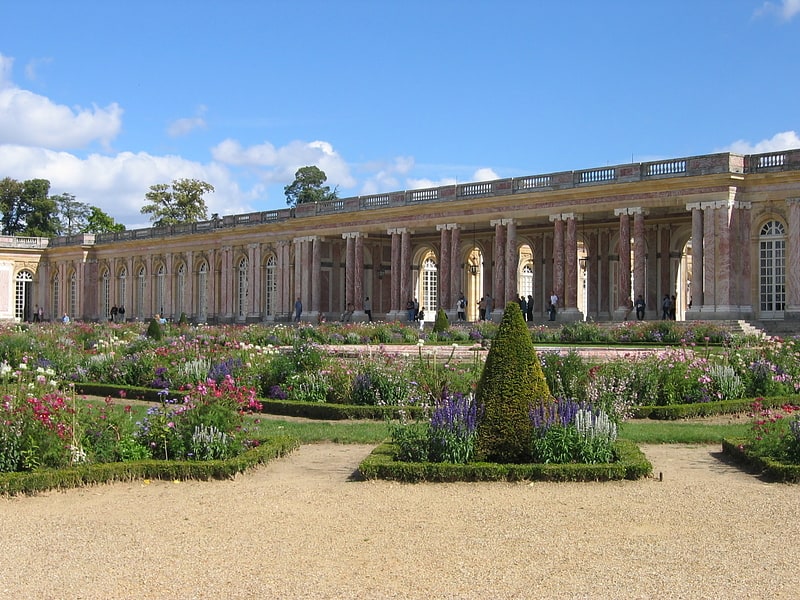
Château in Versailles, France. The Grand Trianon is a French Baroque style château situated in the northwestern part of the Domain of Versailles in Versailles, France. It was built at the request of King Louis XIV of France as a retreat for himself and his maîtresse-en-titre of the time, the Marquise de Montespan, and as a place where he and invited guests could take light meals away from the strict étiquette of the royal court. The Grand Trianon is set within its own park, which includes the Petit Trianon.[15]
Address: Parc du Château de Versailles, 78000 Versailles (Saint-Louis - Château)
Reims Cathedral, Reims

Also known as: Cathédrale Notre-Dame de Reims
Towering 13th-century Gothic church. Notre-Dame de Reims, sometimes known in English as Reims Cathedral, is a Roman Catholic cathedral in the French city of the same name, the archiepiscopal see of the Archdiocese of Reims. The cathedral was dedicated to the Virgin Mary and was the traditional location for the coronation of the kings of France.
The cathedral church is thought to have been founded by the bishop Nicasius in the early 5th century. Clovis was baptized a Christian here by Saint Remigius, the bishop of Reims, about a century later. He was the first Frankish king to receive this sacrament. Construction of the present Reims Cathedral began in the 13th century and concluded in the 15th century. A prominent example of High Gothic architecture, it was built to replace an earlier church destroyed by fire in 1210. Although little damaged during the French Revolution, the present cathedral saw extensive restoration in the 19th century. It was severely damaged during World War I and the church was again restored in the 20th century.
Since the 1905 law on the separation of church and state, the cathedral has been owned by the French state, while the Catholic church has an agreement for its exclusive use. The French state pays for its restoration and upkeep. The cathedral, a major tourist destination, receives about one million visitors annually. It has been a UNESCO World Heritage Site since 1991.[16]
Address: Place du Cardinal Luçon, 51100 Reims
Palace of Tau, Reims
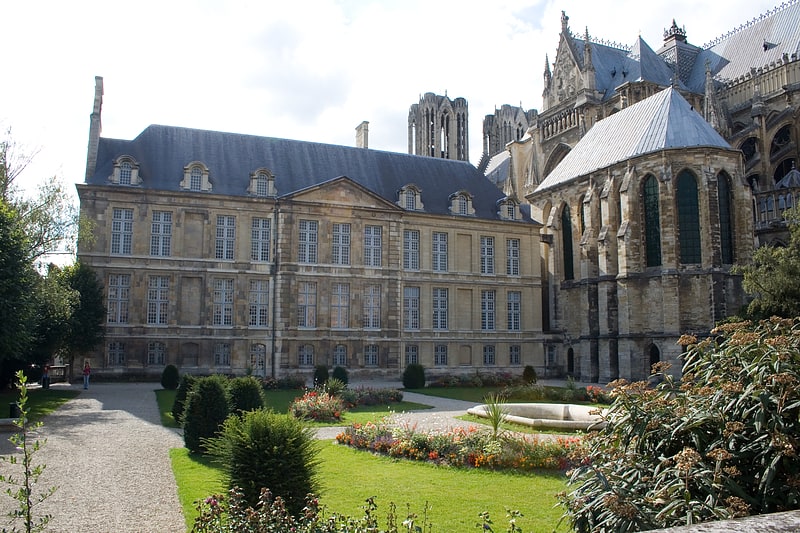
Also known as: Palais du Tau
17th-century royal and episcopal palace. The Palace of Tau in Reims, France, was the palace of the Archbishop of Reims. It is associated with the kings of France, whose coronation was held in the nearby cathedral of Notre-Dame de Reims and the following coronation banquet in the palace itself. Because of its historical importance for the French monarchy, the Palace of Tau was inscribed on the UNESCO World Heritage List in 1991. Today, it serves to host cultural events for the city of Reims. In recent years it has been the setting for Sciences Po Paris's RIMUN association's annual gala.[17]
Address: 2 Place du Cardinal Luçon, 51100 Reims
Palais Rohan, Strasbourg
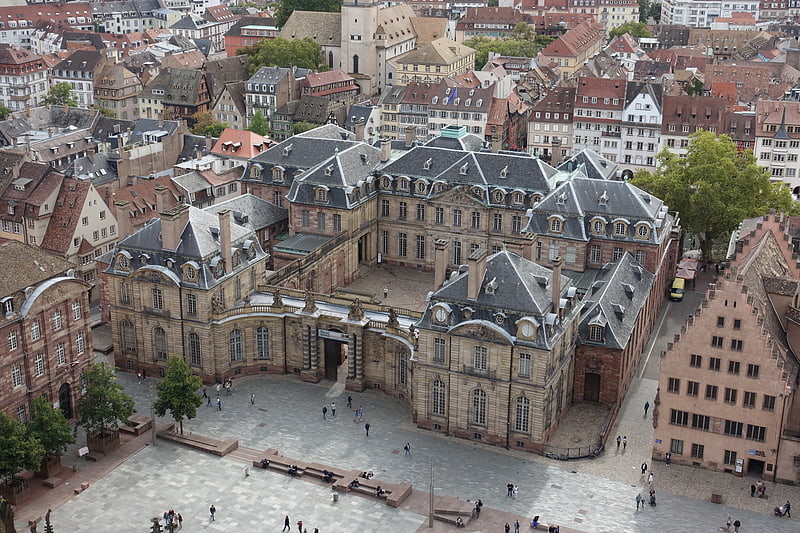
18th-century palace housing musuems. The Palais Rohan in Strasbourg is the former residence of the prince-bishops and cardinals of the House of Rohan, an ancient French noble family originally from Brittany. It is a major architectural, historical, and cultural landmark in the city. It was built next to Strasbourg Cathedral in the 1730s, from designs by Robert de Cotte, and is considered a masterpiece of French Baroque architecture. Since its completion in 1742, the palace has hosted a number of French monarchs such as Louis XV, Marie Antoinette, Napoleon and Joséphine, and Charles X.
Reflecting the history of Strasbourg and of France, the palace has been owned successively by the nobility, the municipality, the monarchy, the state, the university, and the municipality again. Its architectural conception and its iconography were intended to indicate the return of Roman Catholicism to the city, which had been dominated by Protestantism for the previous two centuries. Thus the prelate's apartments face the cathedral, to the north, and many of the statues, reliefs and paintings reflect Catholic dogma.
Since the end of the 19th century the palace has been home to three of Strasbourg's most important museums: the Archaeological Museum (Musée archéologique, basement), the Museum of Decorative Arts (Musée des arts décoratifs, ground floor) and the Museum of Fine Arts (Musée des beaux-arts, first and second floor). The municipal art gallery, Galerie Robert Heitz, in a lateral wing of the palace, is used for temporary exhibitions. The Palais Rohan has been listed since 1920 as a Monument historique by the French Ministry of Culture.[18]
Musée des Beaux-Arts de Lyon, Lyon

Ancient and modern art and artifacts. The Museum of Fine Arts of Lyon is a municipal museum of fine arts in the French city of Lyon. Located near Place des Terreaux, it is housed in a former Benedictine convent which was active during the 17th and 18th centuries. It was restored between 1988 and 1998, remaining open to visitors throughout this time despite the restoration works. Its collections range from ancient Egyptian antiquities to the Modern art period, making the museum one of the most important in Europe. It also hosts important exhibitions of art, for example the exhibitions of works by Georges Braque and Henri Laurens in the second half of 2005, and another on the work of Théodore Géricault from April to July 2006. It is one of the largest art museums in France.[19]
Address: 20 Place des Terreaux, 69001 Lyon (Arrondissement 1ER)
MAMAC, Nice

Also known as: Musée d'Art moderne et d'Art contemporain de Nice
French and American modern art museum. The Musée d'art moderne et d'art contemporain, also known as MAMAC, is a museum dedicated to modern art and contemporary art. It opened on 21 June 1990, in Nice, France.[20]
Address: Avenue Klein, 06000 Nice (Carabacel)
Basilique Saint-Sernin, Toulouse
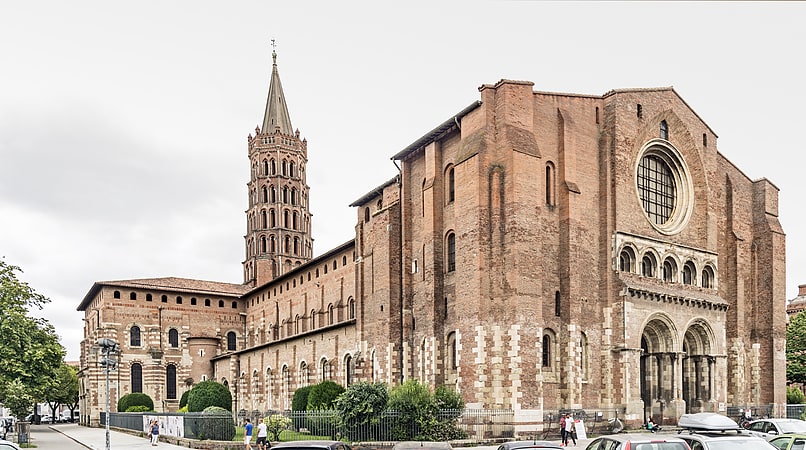
Imposing 11th-century Romanesque church. The Basilica of Saint-Sernin is a church in Toulouse, France, the former abbey church of the Abbey of Saint-Sernin or St Saturnin. Apart from the church, none of the abbey buildings remain. The current church is located on the site of a previous basilica of the 4th century which contained the body of Saint Saturnin or Sernin, the first bishop of Toulouse in c. 250. Constructed in the Romanesque style between about 1080 and 1120, with construction continuing thereafter, Saint-Sernin is the largest remaining Romanesque building in Europe. The church is particularly noted for the quality and quantity of its Romanesque sculpture. In 1998 the basilica was added to the UNESCO World Heritage Sites under the description: World Heritage Sites of the Routes of Santiago de Compostela in France.[21]
Address: Place Saint-Sernin, 31000 Toulouse (Arnaud Bernard)
Villa Kerylos, Nice
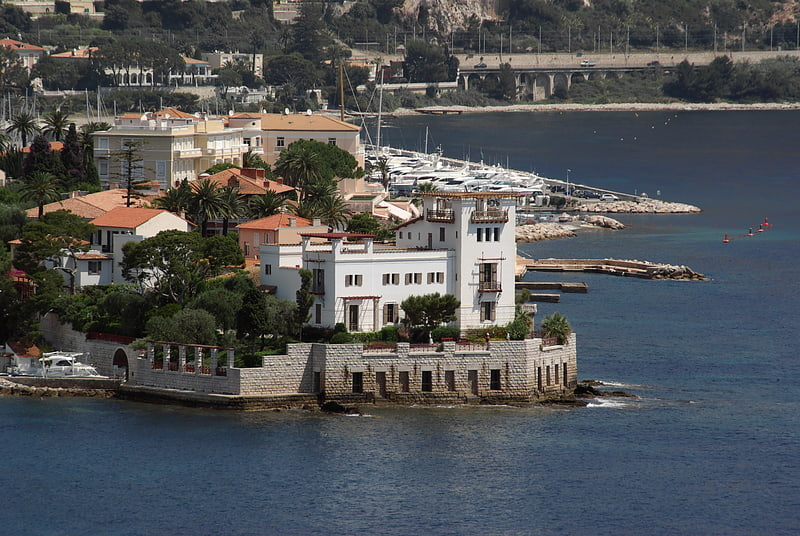
Also known as: Villa Kérylos
Museum in Beaulieu-sur-Mer, France. Villa Kerylos in Beaulieu-sur-Mer, France, is a house in Ancient Greek Revival style built in the early 1900s by French archaeologist Theodore Reinach. It has been listed since 1966 as a monument historique by the French Ministry of Culture.
A Greek word, kerylos means halcyon or kingfisher, which in Greek mythology was considered a bird of good omen.[22]
Address: Impasse Gustave Eiffel, 06310 Beaulieu-sur-Mer
Palais des Beaux-Arts de Lille, Lille
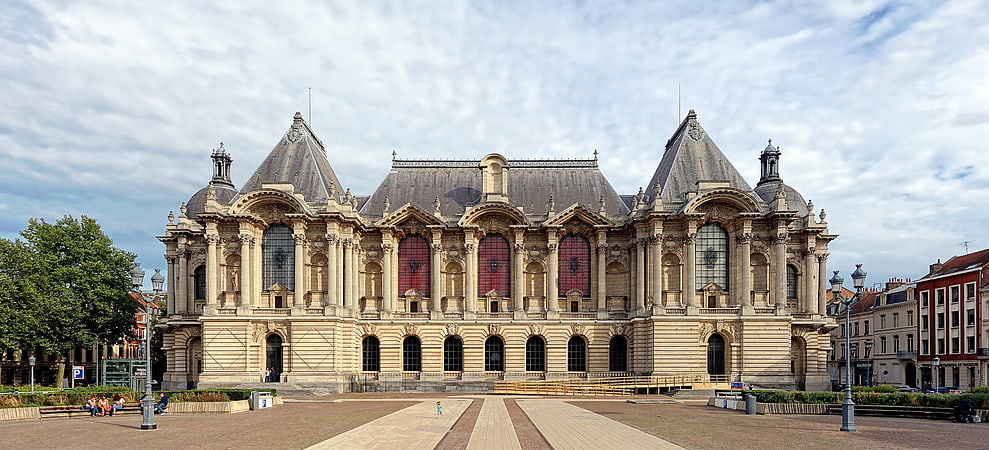
Also known as: Palais des beaux-arts de Lille
Museum in Lille, France. The Palais des Beaux-Arts de Lille is a municipal museum dedicated to fine arts, modern art, and antiquities. It is one of the largest art museums in France.
It was one of the first museums built in France, established under the instructions of Napoleon I at the beginning of the 19th century as part of the popularisation of art. Jean-Antoine Chaptal's decree of 1801 selected fifteen French cities (among which Lille) to receive the works seized from churches and from the European territories occupied by the armies of Revolutionary France. The painters Louis Joseph Watteau and François Watteau, known as the "Watteau of Lille", were heavily involved in the museum's beginnings - Louis Joseph Watteau made in 1795 the first inventory of the paintings confiscated during the Revolution, whilst his son François was deputy curator of the museum from 1808 to 1823.
The museum opened in 1809 and was initially housed in a church confiscated from the Récollets before being transferred to the city's town hall. In 1866, the "musée Wicar", formed from the collection of Jean-Baptiste Wicar, was merged into the Palais des Beaux-Arts. Construction of the Palais's current Belle Époque-style building began in 1885 under the direction of Géry Legrand, mayor of Lille, and it was completed in 1892. The architects chosen to design the new building were Edouard Bérard (1843–1912) and Fernand Etienne-Charles Delmas (1852–1933) from Paris. The building is located on the place de la République, in the center of the city, facing the préfecture of Lille. It was renovated during the 1990s and reopened in 1997.
At the start of the 1990s, the building's poor state and the moving of Vauban's relief models of fortified towns to Lille forced the town to renovate the building. Work began in 1991, under the architects Jean-Marc Ibos and Myrto Vitart, and was completed in 1997. This allowed the creation of a new 700 m2 basement room for temporary exhibitions, as well as departments for the relief models and for 19th-century sculpture. Overall the museum covers 22000 m2 and held 72430 pieces as of 2015, one of the largest provincial collections of fine art. The collection includes works by Raphael, Donatello, Van Dyck, Tissot, Jordaens, Rembrandt, Goya, El Greco, David, Corot, Courbet, Toulouse-Lautrec, Delacroix, Rubens, Rodin, Claudel and Jean-Baptiste Chardin.[23]
Address: Place de la République, 59000 Lille
Canal du Midi, Toulouse

Canal in France. The Canal du Midi is a 240 km long canal in Southern France. Originally named the Canal royal en Languedoc and renamed by French revolutionaries to Canal du Midi in 1789, the canal is considered one of the greatest construction works of the 17th century.
The canal connects the Garonne to the Étang de Thau on the Mediterranean and along with the 193 km (120 mi) long Canal de Garonne forms the Canal des Deux Mers, joining the Atlantic to the Mediterranean. The canal runs from the city of Toulouse down to the Étang de Thau near the Mediterranean.
Strictly speaking, "Canal du Midi" refers to the portion initially constructed from Toulouse to the Mediterranean – the Deux-Mers canal project aimed to link together several sections of navigable waterways to join the Mediterranean and the Atlantic: first the Canal du Midi, then the Garonne which was more or less navigable between Toulouse and Bordeaux, then the Garonne Lateral Canal built later, and finally the Gironde estuary after Bordeaux.
Jean-Baptiste Colbert authorized the start of work by royal edict in October, 1666, with the aim of developing the wheat trade, under the supervision of Pierre-Paul Riquet, and construction lasted from 1666 to 1681, during the reign of Louis XIV. The Canal du Midi is one of the oldest canals of Europe still in operation (the prototype being the Briare Canal). The challenges in these works are closely related to the challenges of inland water transport today. The key challenge, raised by Pierre-Paul Riquet, was to convey water from the Montagne Noire (Black Mountains) to the Seuil de Naurouze, the highest point of the canal.
The Canal du Midi was inscribed as a UNESCO World Heritage Site in 1996, because of its outstanding engineering and artistic design, and it was designated as an International Historic Civil Engineering Landmark in 2016.[24]
Amiens Cathedral, Amiens
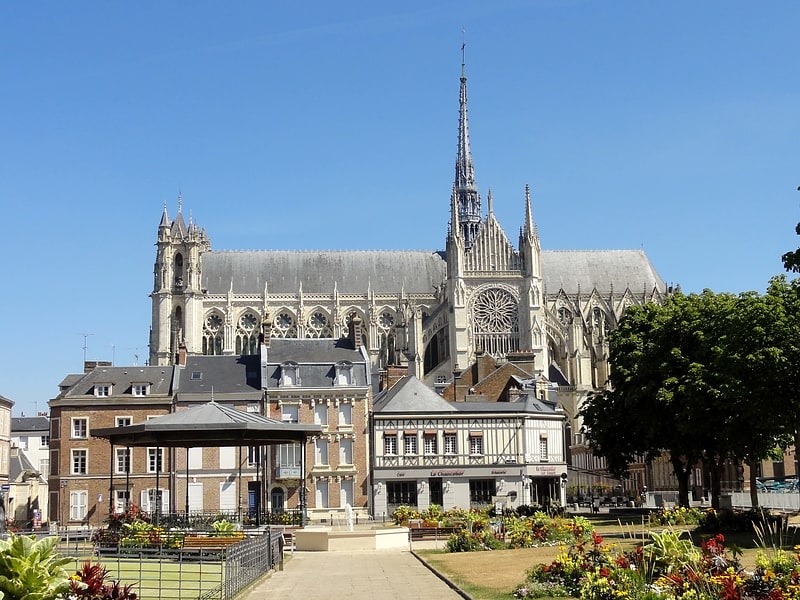
Also known as: Cathédrale Notre-Dame d'Amiens
Gothic cathedral with ornate sculptures. The Cathedral Basilica of Our Lady of Amiens, or simply Amiens Cathedral, is a Roman Catholic church. The cathedral is the seat of the Bishop of Amiens. It is situated on a slight ridge overlooking the River Somme in Amiens, the administrative capital of the Picardy region of France, some 120 kilometres north of Paris.
The cathedral was built almost entirely between 1220 and c. 1270, a remarkably short period of time for a Gothic cathedral, giving it an unusual unity of style. Amiens is a classic example of the High Gothic style of Gothic architecture. It also has some features of the later Rayonnant style in the enlarged high windows of the choir, added in the mid-1250s.
Its builders were trying to maximize the internal dimensions in order to reach for the heavens and bring in more light. As a result, Amiens cathedral is the largest in France, 200,000 cubic metres (260,000 cu yd), large enough to contain two cathedrals the size of Notre Dame of Paris.
The cathedral has been listed as a UNESCO World Heritage Site since 1981. Although it has lost much of its original stained glass, Amiens Cathedral is renowned for the quality and quantity of early 13th-century Gothic sculpture in the main west façade and the south transept portal, and a large quantity of polychrome sculpture from later periods inside the building.[25]
Address: 30 Place Notre Dame, 80000 Amiens
Muséum de Toulouse, Toulouse
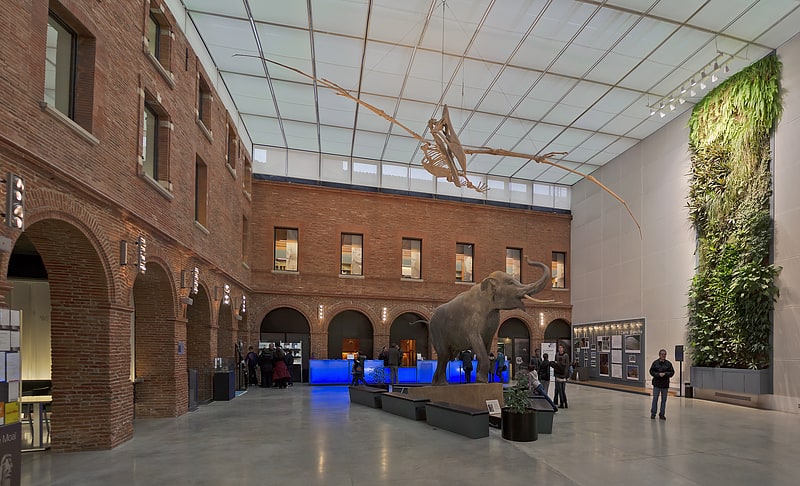
Natural history museum and gardens. The Muséum de Toulouse is a museum of natural history in Toulouse, France. It is in the Busca-Montplaisir, houses a collection of more than 2.5 million items, and has some 3,000 square metres of exhibition space. Its Index Herbariorum code is TLM.[26]
Address: 35 Allée Jules Guesde, 31000 Toulouse (Le Busca)
Miroir d'eau, Bordeaux
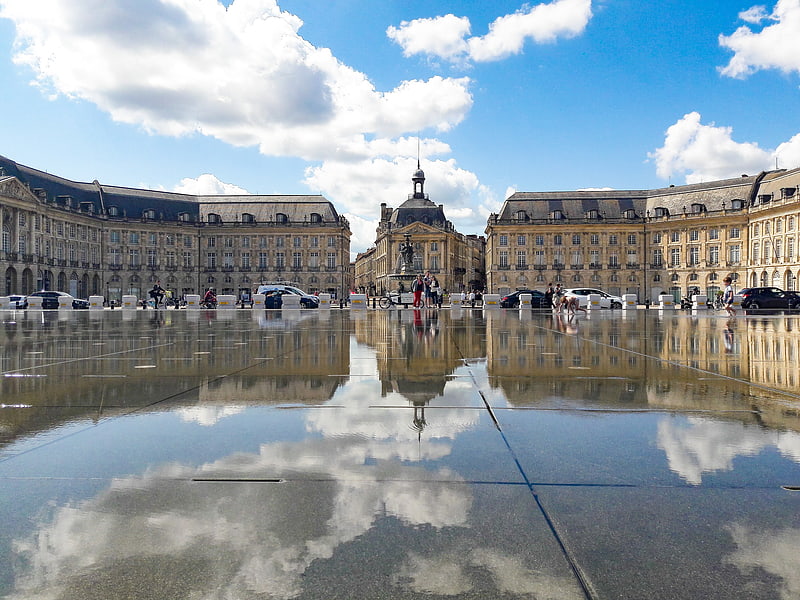
Tourist attraction in Bordeaux, France. The Miroir d'eau in Bordeaux is the world's largest reflecting pool, covering 3,450 square metres. Located on the quay of the Garonne in front of the Place de la Bourse, it was built in 2006.
In the context of the quays embellishment operation (2000s), it was designed by landscape artist Michel Corajoud. Then it was built by the fountain-maker Jean-Max Llorca and the architect Pierre Gangnet, who reused a former underground warehouse to set the machinery and reservoir.
The reflecting pool is made of granite slabs covered by 2 cm of water, and a system allows it to create mist every 15 minutes.
The Miroir d'eau works only from April to October, and it is the most-photographed site of the Port of the Moon.[27]
Tour Pey Berland, Bordeaux
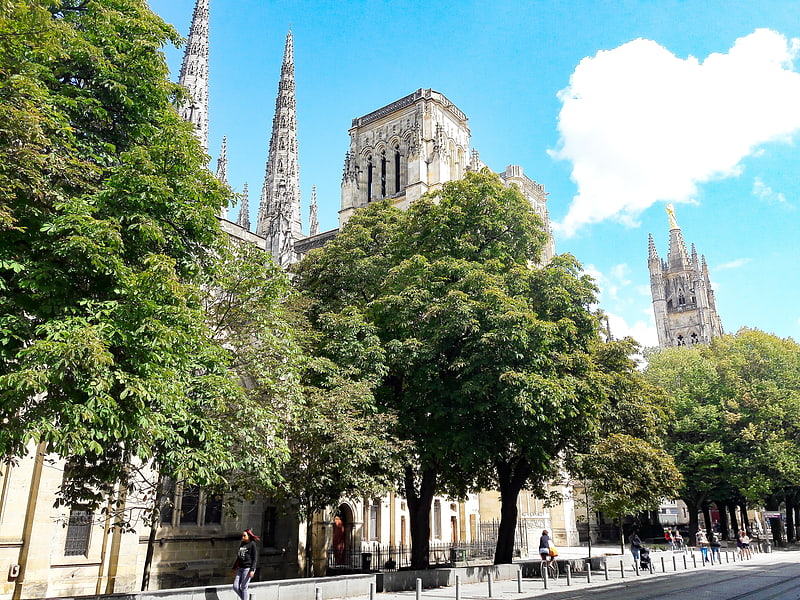
Gothic bell tower with panoramic views. The Tour Pey-Berland, named for its patron Pey Berland, is the separate bell tower of the Bordeaux Cathedral, in Bordeaux at the Place Pey Berland.[28]
Address: Place Pey-Berland, 33000 Bordeaux (Hôtel de Ville Quinconces)
Château d'Angers, Angers
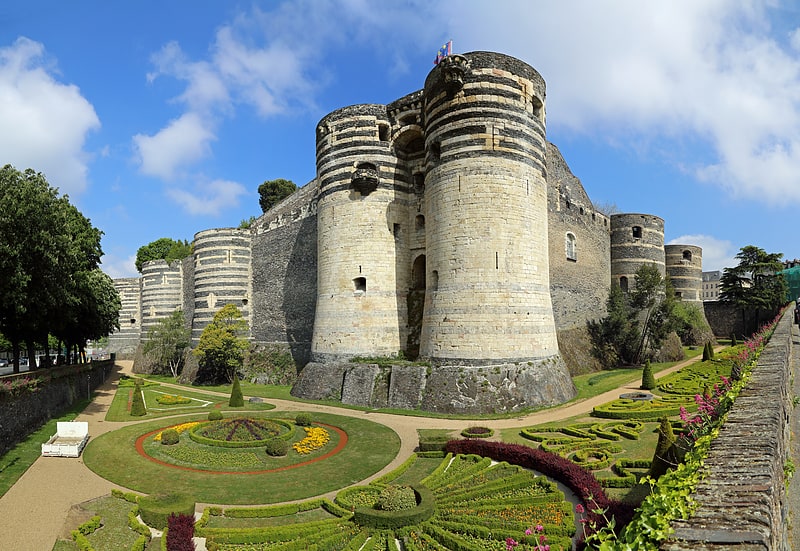
Landmark 9th-century fortress. The Château d'Angers is a castle in the city of Angers in the Loire Valley, in the département of Maine-et-Loire, in France. Founded in the 9th century by the Counts of Anjou, it was expanded to its current size in the 13th century. It is located overhanging the river Maine. It is a listed historical monument since 1875. Now open to the public, the Château d'Angers is home of the Apocalypse Tapestry.[29]
Address: 2 Promenade du Bout du Monde, 49100 Angers (Centre ville la Fayette)
Arles Amphitheatre, Arles

Also known as: Arènes d'Arles
2-tiered amphitheatre with bullfights. The Arles Amphitheatre is a Roman amphitheatre in the southern French town of Arles. Two-tiered, it is probably the most prominent tourist attraction from the city which thrived in Ancient Rome. The towers jutting out from the top are medieval add-ons.
Built in 90 AD, the amphitheatre held over 20,000 spectators of chariot races and bloody hand-to-hand battles. Lately, it draws smaller crowds for bullfighting during the Feria d'Arles as well as plays and concerts in summer.
In 1981, Arles Amphitheatre was listed as a UNESCO World Heritage Site, together with other Roman and medieval buildings of the city, as part of the Arles, Roman and Romanesque Monuments group.[30]
Address: 1 Rond-Point des Arènes, 13200 Arles
Musée de Grenoble, Grenoble
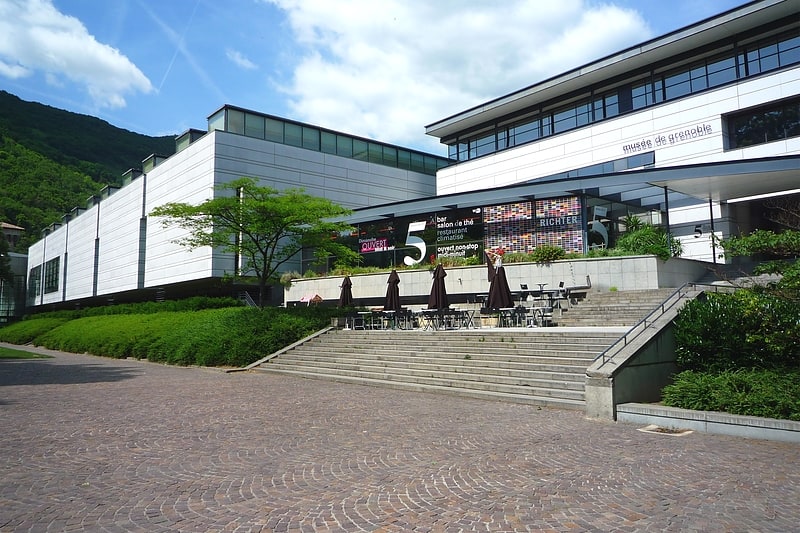
Art museum with European masterpieces. The Museum of Grenoble is a municipal museum of Fine Arts and antiquities in the city of Grenoble in the Isère region of France.
Located on the left bank of the Isère River, place Lavalette, it is known both for its collections of ancient art for its collections of modern and contemporary art. Thanks to the action of one of its curators of the interwar period (Andry-Farcy), it is considered the very first museum of modern art in France.
Its temporary rooms allow it to organize two exhibitions each year.[31]
Address: 5 Place de Lavalette, 38000 Grenoble (Grand Quartier 2)
Musée de l'Œuvre Notre-Dame, Strasbourg
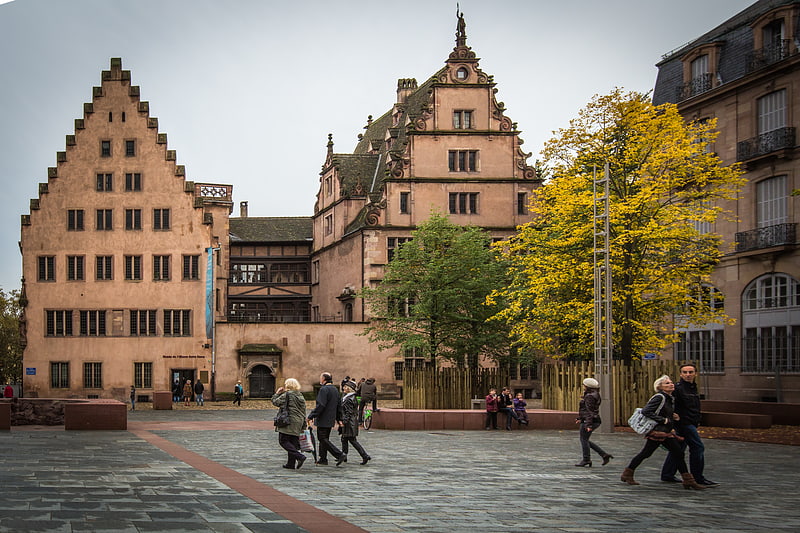
Museum tracing the history of the city. The Musée de l'Œuvre Notre-Dame is the city of Strasbourg's museum for Upper Rhenish fine arts and decorative arts, dating from the early Middle Ages until 1681. The museum is famous for its collection of original sculptures, glass windows, architectural fragments, as well as the building plans of Strasbourg Cathedral. It has a considerable collection of works by Peter Hemmel von Andlau, Niclas Gerhaert van Leyden, Nikolaus Hagenauer, Ivo Strigel, Konrad Witz, Hans Baldung and Sebastian Stoskopff.[32]
Address: 3 Place du Château, 67000 Strasbourg (Grand-Île)
Abbey of Saint-Remi, Reims

Also known as: Basilique Saint-Remi de Reims
Medieval church housing St Rémi's tomb. The Musée Saint-Remi is an archeology and art museum in Reims, France. The museum is housed in the former Abbey of Saint-Remi, founded in the sixth century and which had been keeping since 1099 the relics of Saint Remigius. The Basilica of Saint-Remi, adjacent to it and consecrated in 1049, was its abbey church. Both buildings have been listed as part of a UNESCO World Heritage Site since 1991 because of their outstanding architecture and importance in the early French monarchy.[33]
Address: Rue Saint-Julien, 51100 Reims (Saint-Rémi)
Museum of Fine Arts, Rouen
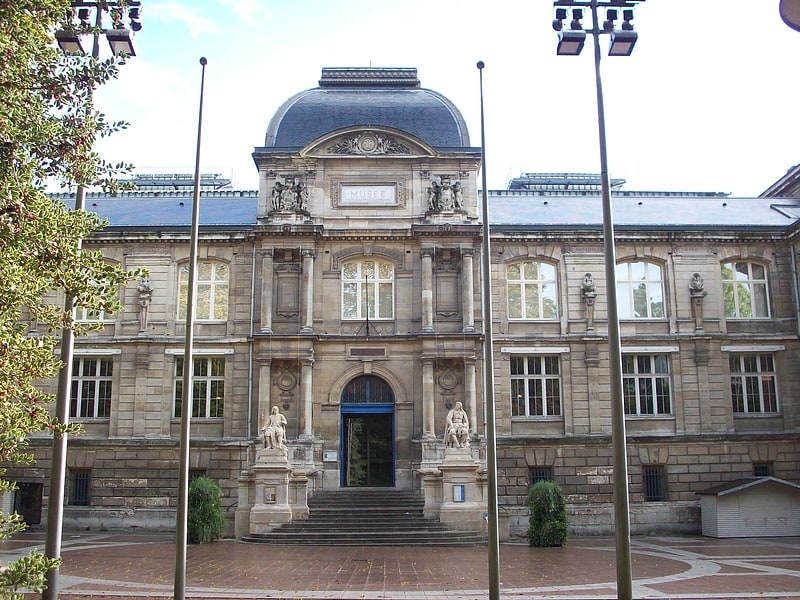
Also known as: Musée des Beaux-Arts
Major artworks in 19th-century museum. The Musée des Beaux-Arts de Rouen is an art museum in Rouen, in Normandy in north-western France. It was established by Napoléon Bonaparte in 1801, and is housed in a building designed by Louis Sauvageot and built between 1877 and 1888. Its collections include paintings, sculptures, drawings and objets d'art.[34]
Address: Espl. Marcel Duchamp, 76000 Rouen (Centre Rive Droite Ouest)
Docks, Marseille
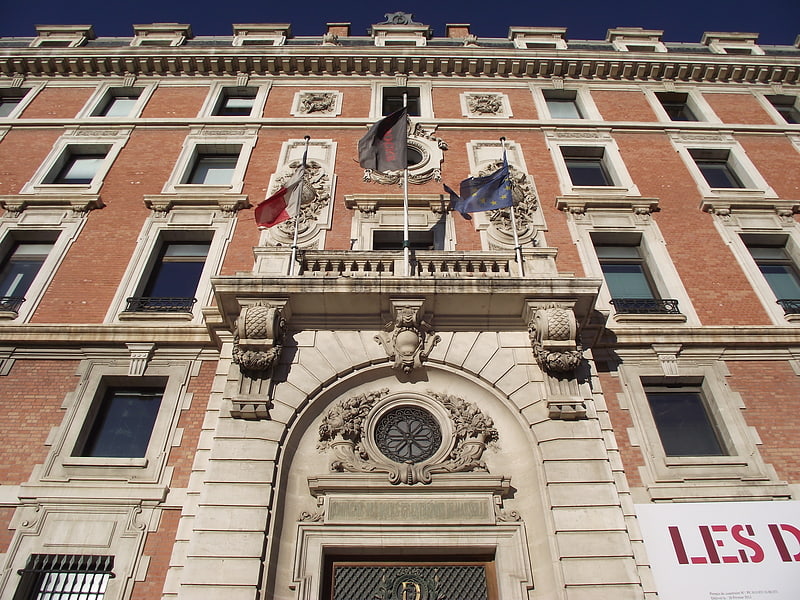
Les Docks de Marseille is a historical building in the heart of La Joliette, a business district in Marseille, France. The building is home to 220 companies employing some 3,500 people. Various corporate headquarters, regional branches, restaurants, and services are located inside.[35]
Address: 10 Place de la Joliette, 13002 Marseille (2ème Arrondissement)
Musée de la Romanité, Nîmes
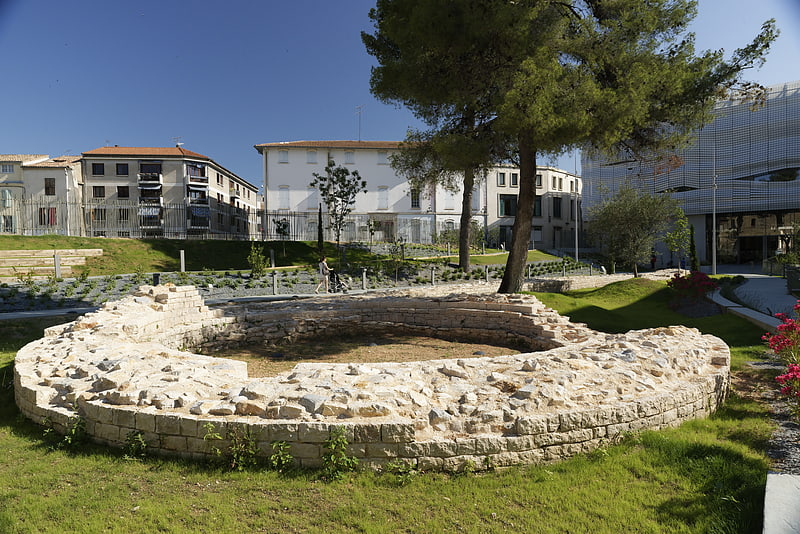
Musée de la Romanité is an archeological museum in the French city of Nîmes, opened on 2 June 2018.[36]
Address: 16 Boulevard des Arènes, Nîmes (Quartier Administrations)
Place Stanislas, Nancy
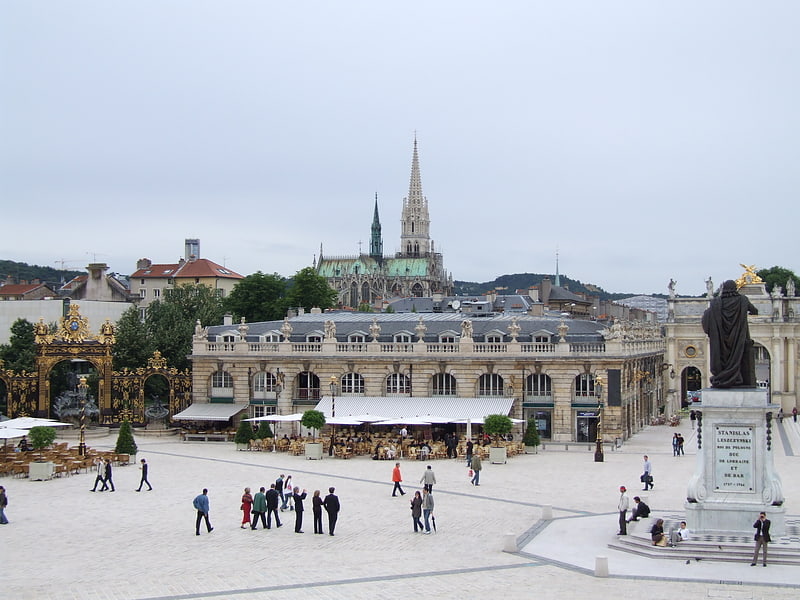
UNESCO-listed 18th-century royal square. Place Stanislas is a large pedestrianised square in the French city of Nancy, in the Lorraine historic region. Built between 1752 and 1756 on the orders of Stanisław Leszczyński, the square is one of oldest examples of an architecturally consistent and monumental public square, and is an excellent example of 18th-century urban architecture. Since 1983, the architectural ensemble comprising Place Stanislas, the extension of its axis, the Place de la Carrière and the Place d'Alliance, has been a UNESCO World Heritage Site.[37]
Address: 22 Rue Héré, 54000 Nancy (Léopold - Ville Vieille)
Vieux-Port, Marseille
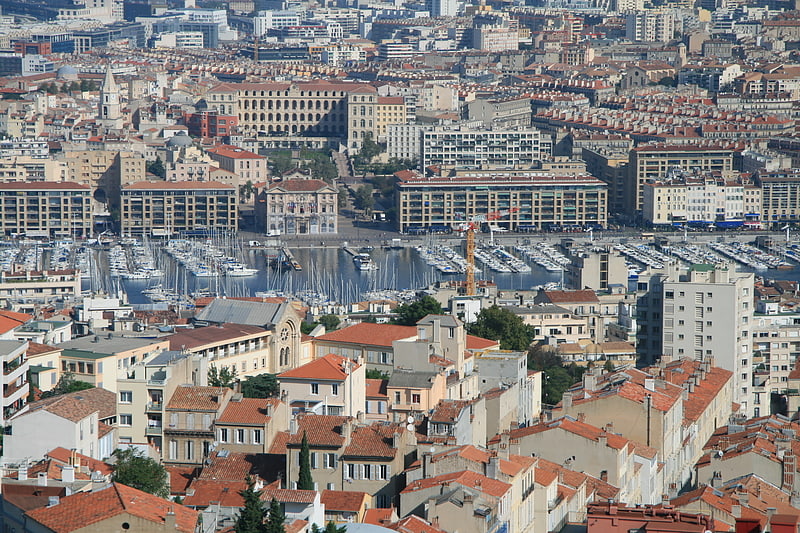
The Old Port of Marseille is at the end of the Canebière, the major street of Marseille. It has been the natural harbour of the city since antiquity and is now the main popular place in Marseille. It became mainly pedestrian in 2013.[38]
Address: Quai du Port, 13001 Marseille
Mémorial de Caen, Caen
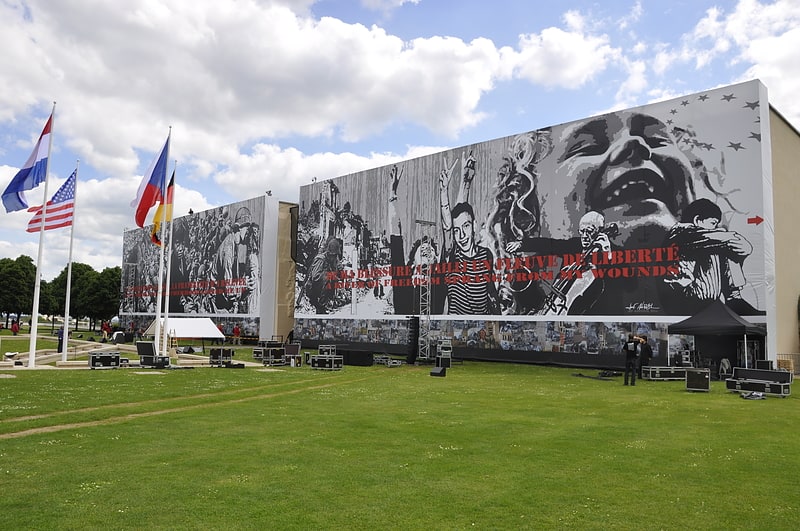
WWII, D-Day and Cold War memorial and museum. The Mémorial de Caen is a museum and war memorial in Caen, Normandy, France commemorating World War II and the Battle for Caen. More generally, the museum is dedicated to the history of the twentieth century, mainly focused on the fragility of peace. Its intention is "pay a tribute to the martyred city of the liberation" but also to tell "what was the terrible story of the 20th century in a spirit of reconciliation".[39]
Address: Esplanade Général Eisenhower, 14050 Caen (La Folie Couvrechef)
Maritime, Rouen
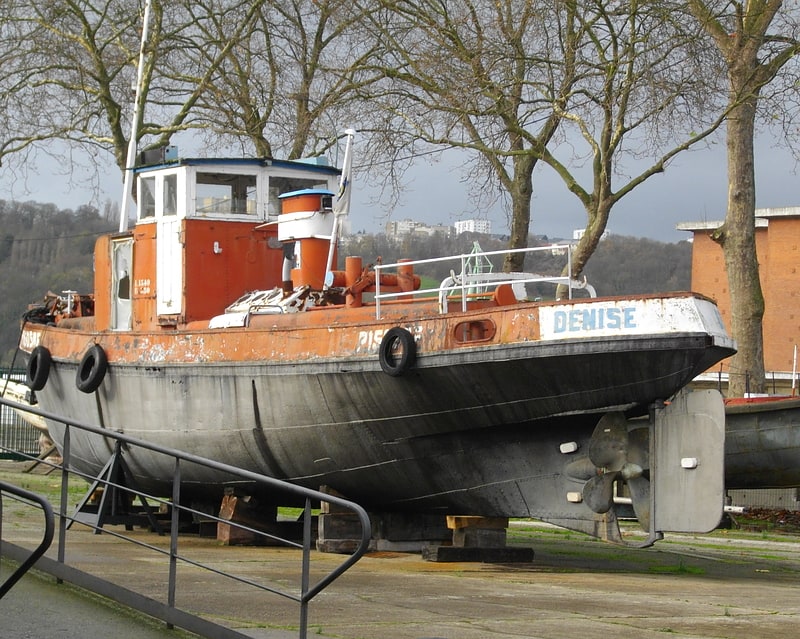
Also known as: Musée maritime fluvial et portuaire de Rouen
Museum of region's maritime history. The Maritime, Fluvial and Harbour Museum of Rouen is a museum dedicated to the history of the port of Rouen, which is one of the greatest ports of France. The museum opened in 1999, during the Rouen Armada, a festival of tall ships which takes place every five years.[40]
Address: Quai Emile Duchemin, 76000 Rouen (Quartiers Ouest)
Covered Market, Metz
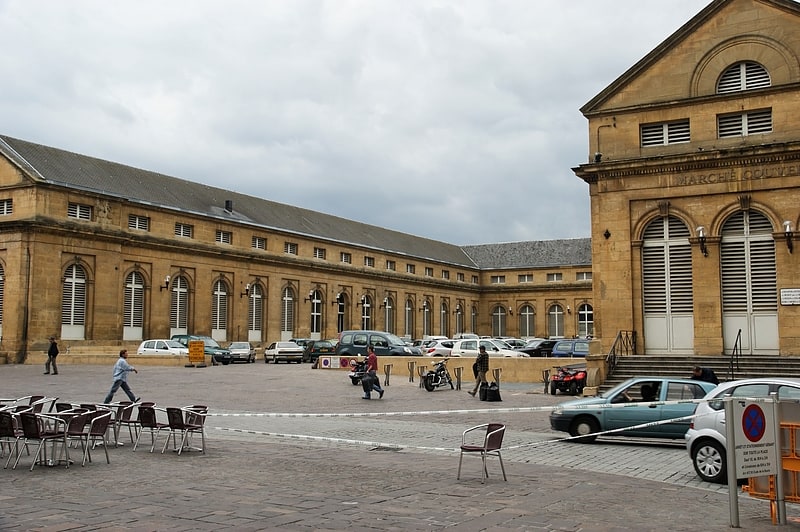
Also known as: Marché couvert de Metz
The Metz Covered Market is a historic market with permanent stalls and shops in a large covered structure in the historical centre of Metz, capital of the Lorraine region in France. The Covered Market is one of the oldest, most grandiose in France and is home to traditional local food producers and retailers.[41]
Maison Folie Wazemmes, Lille
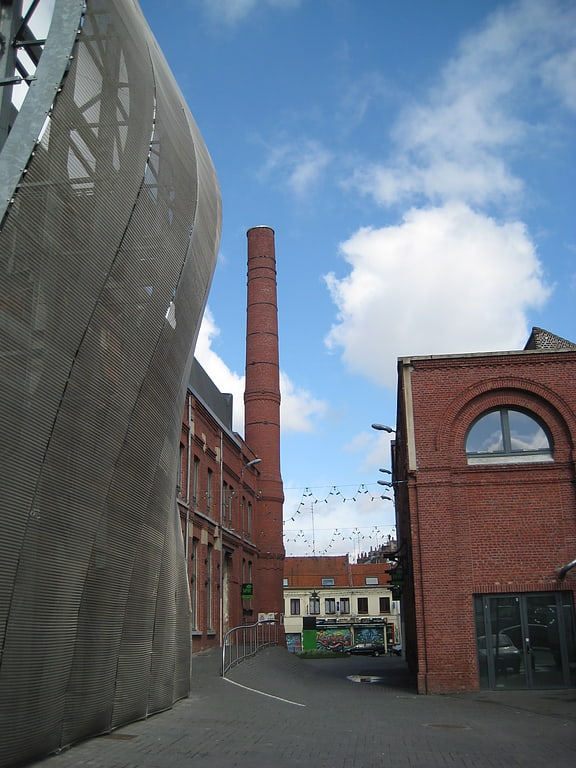
The Maison Folie Wazemmes is a cultural facility of the City of Lille, opened on the occasion of the Lille 2004 event, European Capital of Culture. This former textile mill was rehabilitated by the Dutch agency Nox and the architect Lars Spuybroek accompanied by Ducks Scéno is a French company based in Villeurbanne specializing in scenography and museography. for the design of the scenography of the 250-seat auditorium and the recording studio and Flanders Analyzes for the acoustic studies, to become in 2004, the house Folie Wazemmes.[42]
Address: 70 rue des Sarrasins, 59000 Lille
Cité de l'Automobile, Mulhouse
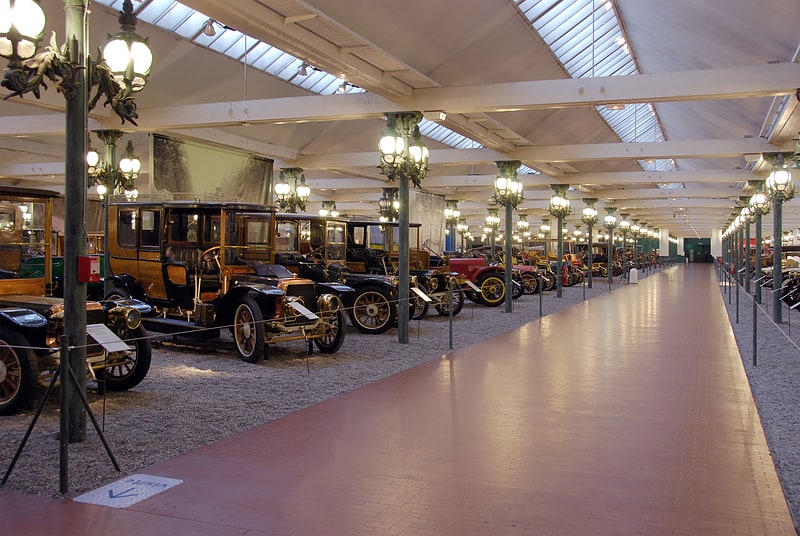
Also known as: Cité de l'automobile
Vast car museum with exhibition track. Musée National de l’Automobile, Collection Schlumpf is an automobile museum located in Mulhouse, France, and built around the Schlumpf Collection of classic automobiles. It has the largest displayed collection of automobiles and contains the largest and most comprehensive collection of Bugatti motor vehicles in the world.[43]
Address: 15 Rue de l'Épée, 68100 Mulhouse (Wolf Wagner)
Rouen Cathedral, Rouen

Also known as: Cathédrale Notre-Dame de Rouen
Cathedral famously depicted by Monet. Rouen Cathedral is a Roman Catholic church in Rouen, Normandy, France. It is the see of the Archbishop of Rouen, Primate of Normandy. It is famous for its three towers, each in a different style. The cathedral, built and rebuilt over a period of more than eight hundred years, has features from Early Gothic to late Flamboyant and Renaissance architecture. It also has a place in art history as the subject of a series of impressionist paintings by Claude Monet.[44]
Address: Place de la Cathédrale, 76000 Rouen (Centre Rive Droite Ouest)
Nantes Cathedral, Nantes
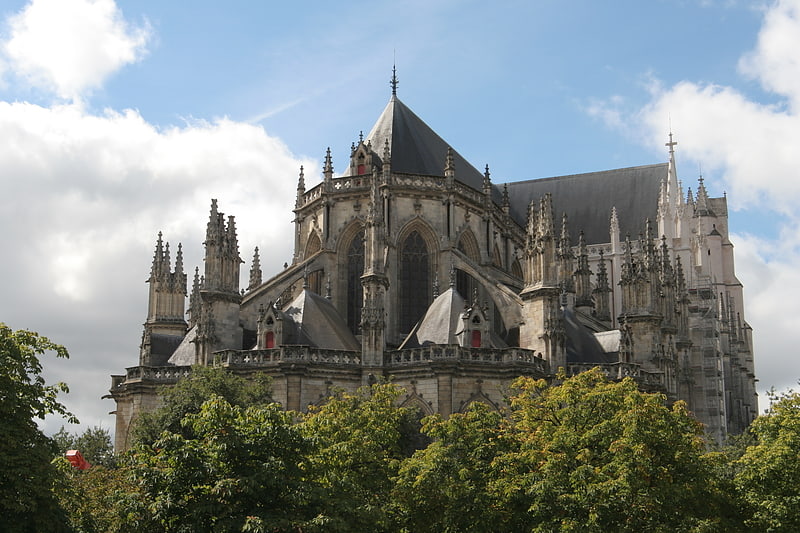
Also known as: Cathédrale Saint-Pierre-et-Saint-Paul de Nantes
Gothic cathedral with Renaissance tombs. Nantes Cathedral, or the Cathedral of St. Peter and St. Paul of Nantes, is a Roman Catholic Gothic cathedral located in Nantes, Pays de la Loire, France. Construction began in 1434, on the site of a Romanesque cathedral, and took 457 years to finish in 1891. It has been listed since 1862 as a monument historique by the French Ministry of Culture.[45]
Address: 7 Impasse Saint-Laurent, Nantes (Centre Ville Nantes)
Church of St. Trophime, Arles
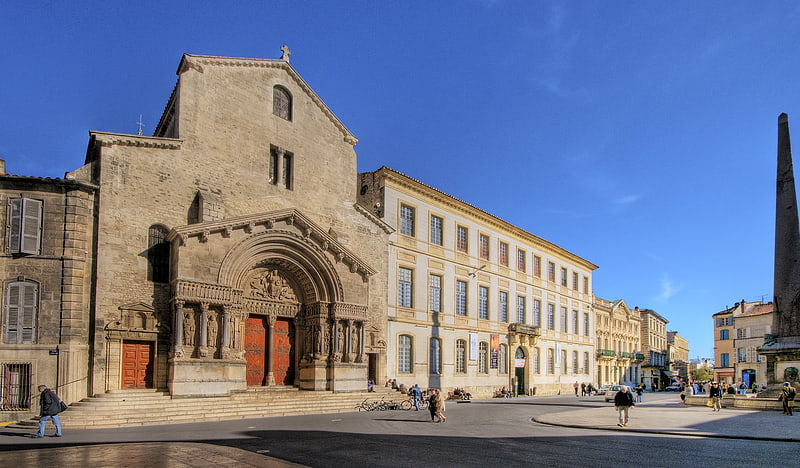
Also known as: Cathédrale Saint-Trophime d'Arles
Romanesque-style church with sculptures. The Church of St. Trophime is a Roman Catholic church and former cathedral located in the city of Arles, in the Bouches-du-Rhône Department of southern France. It was built between the 12th century and the 15th century, and is in the Romanesque architectural tradition. The sculptures over the church's portal, particularly the Last Judgement, and the columns in the adjacent cloister, are considered some of the finest examples of Romanesque sculpture.
The church was built upon the site of the 5th-century basilica of Arles, named for St. Stephen. In the 15th century a Gothic choir was added to the Romanesque nave.
Along with other medieval and Roman buildings in Arles, in 1981 the church was designated a UNESCO World Heritage Site as part of the Arles, Roman and Romanesque Monuments group.[46]
Address: Place de la Republique, 13200 Arles
Grands Moulins de Paris, Lille
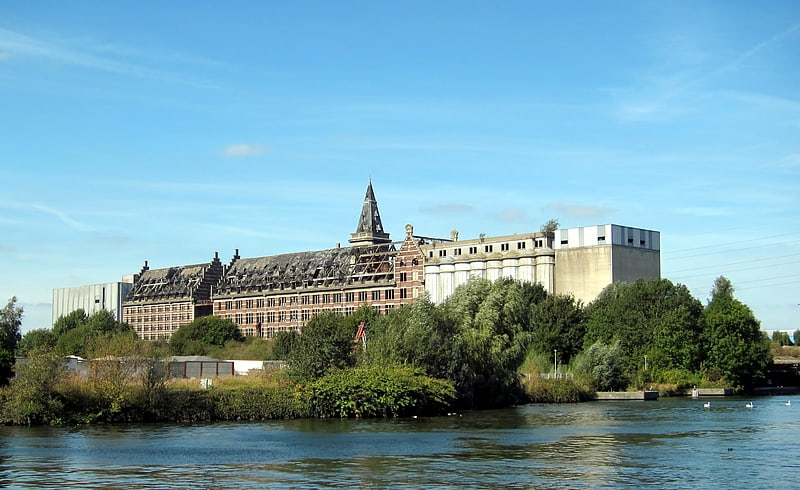
The Grands Moulins de Paris is a disused flour mill located in Marquette-lez-Lille in the Nord department, France. It has been an official Historical Monument since 2001.[47]
Abbaye de Montmajour, Arles

Ruins of prominent abbey and scenic views. Montmajour Abbey, formally the Abbey of St. Peter in Montmajour, was a fortified Benedictine monastery built between the 10th and 18th centuries on what was originally an island five kilometers north of Arles, in what is now the Bouches-du-Rhône Department, in the region of Provence in the south of France.
The abbey complex consists of six sections:
- the hermitage, dating from the 11th century, which includes the Chapel of St. Peter;
- the cloister, built during the 12th and 13th centuries;
- the adjacent Chapel of the Holy Cross, built during the 12th century;
- the fortified Monastery of St. Peter, built during the 14th century;
- the Tower of Abbot Pons de l'Orme, dating from the same period;
- the Maurist monastery, built in the 17th century.
The abbey is noted for its 11th–14th-century graves, carved in the rock, its subterranean crypt, and its massive unfinished church. It was an important pilgrimage site during the Middle Ages, and in the 18th century it was the site of a large Maurist monastery, now in ruin. The abbey and the landscape around it were frequently painted and drawn by Vincent van Gogh. In 1967, production for 1968 film, The Lion in Winter featured the abbey, Katharine Hepburn's dressing room infamously accommodated in the basement.
It has been listed since 1840 as a monument historique by the French Ministry of Culture. Today the ruins of the abbey are cared for as a historic monument by the Centre des monuments nationaux.[48]
Address: Route de Fontvieille, 13280 Arles
Centre Pompidou-Metz, Metz
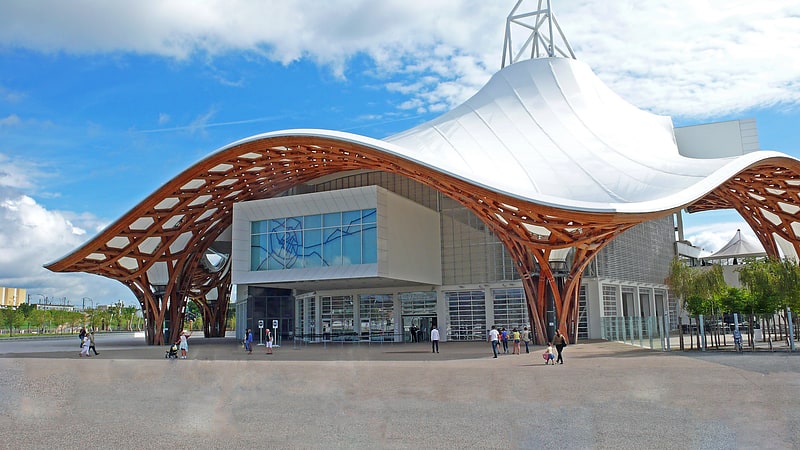
Futuristic contemporary arts center. The Centre Pompidou-Metz is a museum of modern and contemporary art located in Metz, capital of Lorraine, France. It is a branch of Pompidou arts centre of Paris, and features semi-permanent and temporary exhibitions from the large collection of the French National Museum of Modern Art, the largest European collection of 20th and 21st century arts. The museum is the largest temporary exhibition space outside Paris in France with 5,000 m2 divided between 3 galleries, a theatre, and an auditorium.
The first piece of the monument designed by Japanese architect Shigeru Ban was laid on November 7, 2006, and the building was inaugurated by French President Nicolas Sarkozy on May 12, 2010. The building is remarkable for its roof structure, one of the largest and most complex built to date, which was inspired by a Chinese hat found in Paris by Shigeru Ban.
Since its inauguration, the institution has become one of the most visited cultural venues in France outside Paris.[49]
Address: 1 parvis des Droits de l'Homme, 57020 Metz (Sablon)
Maison Carrée, Nîmes
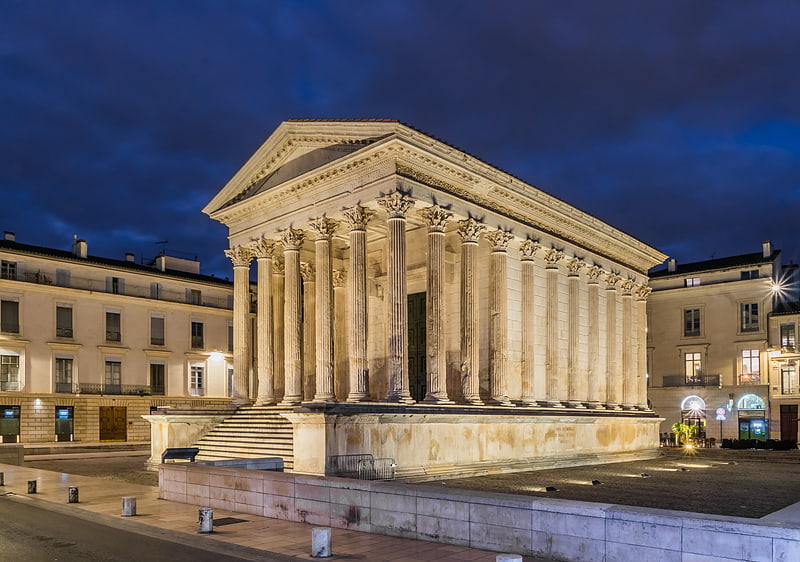
Roman temple and archaeological site. The Maison carrée is an ancient Roman temple in Nîmes, southern France; it is one of the best preserved Roman temples to survive in the territory of the former Roman Empire.
The Maison carrée inspired the neoclassical Église de la Madeleine in Paris, St. Marcellinus Church in Rogalin, Poland, and in the United States the Virginia State Capitol, which was designed by Thomas Jefferson, who had a stucco model made of the Maison carrée while he was minister to France in 1785.[50]
Address: Place de la Maison Carree, 30000 Nimes (Centre Ville Nimes)